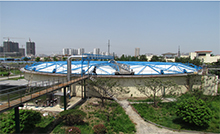冻融处理对淀粉膜结构、热稳定性、机械性能及物理性质的影响
发布时间:2021年3月17日 点击数:4424
Nowadays, extensive attention has been paid to the edible film made from biopolymers due to the essential role in replacing plastic packaging on food products
The biopolymers for producing edible films can be derived from different origins, including polysaccharides, proteins or lipids
When stored in different environmental conditions, starch films undergo physical or chemical changes which affect their retrogradation kinetics and result in property variations
The major purpose of this study was to investigate the effects of F-T treatment on the properties of starch films including native potato starch (PS), hydroxypropyl distarch phosphate (HDP), acetate starch (AS), oxidized starch (OS). The property parameters included microstructure, mechanical property, water sensitivity, and thermostability.
1Materials and methods
1.1Materials
Native potato starch (PS), hydroxypropyl distarch phosphate (HDP, hydroxypropyl content of 3.0%) and acetate starch (AS, acetyl content of 1.4%) were provided by GLDARK PMS. Oxidized potato starch (OS, carboxyl content of 1.0%) was provided by Hangzhou STARPRO starch company. Glycerol, of analytical grade, was purchased from Aladdin.
1.2Preparation of edible films
Edible films were processed by casting method as previously reported with some modifications
Table 1 Compositions and viscosity values of film-forming solutions for native and modified potato starches. 导出到EXCEL
|
Systems |
Starch (w/v, %) |
Glycerol (w/v, %) |
Viscosity (Ps·S) |
|
PS 1 |
2.5 |
0.625 |
3.05±0.13b |
|
HDP |
3.0 |
0.750 |
2.34±0.44a |
|
AS |
2.5 |
0.625 |
3.79±0.14c |
|
OS |
2.0 |
0.500 |
2.50±0.29a |
1 PS, native potato starch; HDP, hydroxypropyl distarch phosphate; AS, acetate starch; OS, oxidized starch.Different letters in the same row represent significant difference between the averages evaluated by LSD test at 5% significance level. GU: glucose units. RVU: Rapid Visco Unit.
1.3 F-T treatment of edible films
The prepared films along with the glass plates were frozen at -20 ℃ for 24 h, and then thawed at 25 ℃ for 6 h
1.4X-ray diffraction (XRD)
A D8 ADVANCE X-ray diffractometer (Bruker, Germany) was used to observe crystalline structures of starch powder and film (3 cm  3 cm) with Cu-Kα radiation operating at 40 kV and 30 mA. XRD patterns were obtained in an angular range of 5°-35° (2θ) with scanning rate of 5(°)/min.
3 cm) with Cu-Kα radiation operating at 40 kV and 30 mA. XRD patterns were obtained in an angular range of 5°-35° (2θ) with scanning rate of 5(°)/min.
1.5Scanning electron microscope (SEM)
The film was conditioned in desiccator containing P2O5 for 7 days and surface morphology of the film after F-T treatment was observed using a field emission scanning electron microscope (Zeiss, Germany) at 10 kV. The magnification times was 80 000.
1.6Mechanical characterization
The mechanical properties of the edible films were evaluated by determining TS and EB using a TA‐XT2i Texture Analyzer (Stable Microsystems Ltd., UK), and the experiment was repeated eight times for each sample
Film samples were cut into 15 mm × 100 mm strips and clamped using tensile grips probe (A/TG). The initial grip separation was set as 50 mm and tensile speed was 0.8 mm/s. TS (MPa) and EB (%) of the films were calculated as follows:

(1)
where  was the measured maximum tensile strength at break (N), L was the thickness of the sample (mm), W was the width of the sample (mm).
was the measured maximum tensile strength at break (N), L was the thickness of the sample (mm), W was the width of the sample (mm).

(2)
where  was the measured maximum length at break (mm),
was the measured maximum length at break (mm),  was the original length of the sample (mm).
was the original length of the sample (mm).
1.7Water content (WC)
Testing samples (0.5 g in weight) were dried in an oven at 105 ℃ for 24 h. WC was calculated as percentage mass loss. Three replicate measurements were carried out for each sample.
1.8Water solubility (WS)
The samples were first dried overnight and weighted, then conditioned at room temperature in beakers containing 30 mL of distilled water for 24 h, and finally dried to constant weight. WS of the testing samples was calculated as the percentage of mass loss, and the test was repeated three times for each sample.
1.9Water vapor permeability (WVP)
Film samples were cut into rectangular pieces of 80 mm × 80 mm, and sealed over circular acrylic cells (Φ 57 mm × 15 mm) containing distilled water of 11 mL. The cells were placed at RH of 70% and weighted every hour. WVP was calculated as follows

(3)
where m was the weight of water permeated through the film (g), L was the thickness of the sample (mm), A was the permeable area (m2), t was the penetration time (d) and  was water vapor pressure difference (kPa).
was water vapor pressure difference (kPa).
1.10 Thermogravimetry analysis (TGA)
Thermal characterization of edible film was measured by Pyris 1 Thermo Gravimetric Analyzer (PerkinElmer, USA). The testing samples (ca. 5 mg) were crushed, placed in alumina cells, and heated from 30 to 500 ℃ at the speed of 10 ℃/min under the protection of nitrogen with flow rate of 60 mL/min.
1.11 Evaluation criteria
Fuzzy comprehensive evaluation method was used to judge the performance of starch film with multiple experimental factors considered
Positive effect:  (4)
(4)
Negative effect:  (5)
(5)
where X (u) was the function value of a parameter, Xi was the data value of the point to be analyzed, Xmax was the maximum value in the data column of a parameter, and Xmin was the minimum value in the data column of a parameter.
After fuzzy transformation, the performance indexes were turned into cumulative weighted membership value ∑X(u)Y. The larger it was, the better the performance of the film would be. The experimental factors included WVP (negative effect), TS (positive effect), EB (positive effect), and WS (positive effect). The weight subset Y of the comprehensive evaluation was {0.40, 0.2, 0.2, 0.20}.
1.12 Statistical analysis
Experimental data were analyzed by analysis of variance (ANOVA) with SPSS Statistics 19 (version 13.0, Statistical Package for the Social Sciences Inc., USA) and expressed as mean values ± standard deviation. The minimum significant difference (LSD) analysis was performed with the level of significance set at P < 0.05.
2.Results and Analysis
2.1 X-ray diffraction (XRD)
The X‐ray diffractograms of starch powders, and starch films before and after F-T treatment were illustrated in Fig. 1. The diffraction curves of PS powder consisted of peak diffraction and dispersive diffraction, indicating that the PS powder was composed of both crystalline and amorphous regions. PS powder showed a typical B-type pattern with reflection peaks at 2θ vales of 5.6°, 15°, 17°, 22° and 24°

Fig. 1 X-ray diffractograms of native and modified potato starches or starch films. 下载原图
Fig. 1 X-ray diffractograms of native and modified potato starches or starch films.
*PS, native potato starch; HDP, hydroxypropyl distarch phosphate; AS, acetate starch; OS, oxidized starch; F-T, freeze-thaw.
2.2 Scanning electron microscope (SEM)
Starch films before F-T presented homogeneous and smooth surfaces without pores or cracks

Fig.2 Surface morphology of native and modified potato starch films after freeze-thaw treatment. (A), native potato starch film; (B), hydroxypropyl distarch phosphate film; (C), acetate starch film; (D), oxidized starch film. 下载原图
Fig.2 Surface morphology of native and modified potato starch films after freeze-thaw treatment. (A), native potato starch film; (B), hydroxypropyl distarch phosphate film; (C), acetate starch film; (D), oxidized starch film.
2.3 Water content, Water solubility (WS) and Water vapor permeability (WVP) of starch films
As shown in Table 2, the water contents of starch films were all around 20% before F-T, and the values went down after F-T. The reduce might be caused by water evaporation and contributed partly to the changes of water barrier and mechanical properties of the films
Table 2 Water content, water solubility, and water vapor permeability of native and modified potato starch films before and after freeze-thaw treatment1. 导出到EXCEL
|
|
Films |
WC (%) |
WS (%) |
WVP (g mm m-2 d-1 kPa-1) |
|
Before F-T |
PS2 |
20.44±0.16a |
33.20±1.89a |
120.59±1.41a |
|
HDP |
22.10±1.10b |
37.16±1.52b |
118.75±1.12a |
|
|
AS |
21.11±0.10ab |
35.23±1.88ab |
120.68±7.41a |
|
|
OS |
19.99±0.49a |
31.68±2.35a |
122.82±3.07a |
|
|
After F-T |
PS |
17.16±0.55B |
29.24±1.86A |
130.21±4.89B |
|
HDP |
14.66±0.85A |
38.24±2.39C |
116.62±5.66A |
|
|
AS |
15.94±0.81A |
34.28±1.57B |
128.40±3.03B |
|
|
OS |
15.93±0.83A |
29.47±0.16A |
123.04±6.55AB |
1 Assays were performed in triplicate. Mean ± SD values in the same column with different letter are significantly different (p < 0.05). 2 PS, native potato starch; HDP, hydroxypropyl distarch phosphate; AS, acetate starch; OS, oxidized starch. F-T, freeze-thaw; WC, water content; WS, water solubility; WVP, water vapor permeability.
Film solubility in water is a parameter depending on application. Films used for high moisture foods should have low solubility, while edible films should have high solubility
Preventing water transfer between environment and food product was one of the most important functions for food packaging
2.4 Mechanical characterization
The mechanical property of edible film is required for retaining the integrity and resisting against external stress

Fig. 3 Mechanical properties of native and modified potato starch films before and after freeze-thaw treatment. (a) tensile strength (TS, MPa) and (b) percent elongation at break (EB, %). 下载原图
Fig. 3 Mechanical properties of native and modified potato starch films before and after freeze-thaw treatment. (a) tensile strength (TS, MPa) and (b) percent elongation at break (EB, %).
*PS, native potato starch; HDP, hydroxypropyl distarch phosphate; AS, acetate starch; OS, oxidized starch; F-T, freeze-thaw; Different letters mean significant differences (p<0.05).
Generally, crosslinking, esterification and oxidation modifications have positive effects on mechanical properties and water sensibilities of films
After F-T, TS values of all films increased to 3~4 times of original values before F-T. Although the molecular ordering was declined (Fig. 1) and micro-integrity was damaged (Fig. 2), the loss of water (Table 2) was more related to the enhancement of macro-strength
2.5 Thermogravimetry analysis (TGA)
TGA could reflect thermal stability of film by measuring mass loss with temperature increase. It could be seen form Fig. 4a that TG curves of starch films before F-T presented four stages of thermal decomposition.

Fig. 4 Thermogravimetric analysis of native and modified potato starch films before and after freeze-thaw treatment. (a) before freeze-thaw treatment, and (b) after freeze-thaw treatment. 下载原图
Fig. 4 Thermogravimetric analysis of native and modified potato starch films before and after freeze-thaw treatment. (a) before freeze-thaw treatment, and (b) after freeze-thaw treatment.
*PS, native potato starch; HDP, hydroxypropyl distarch phosphate; AS, acetate starch; OS, oxidized starch
The first degradation stage occurred below 30-150 ℃ could be attributed to water loss. According to literature
2.6 Comprehensive evaluation
As seen from Table 3, PS film presented the best performance before F-T (0.67), indicating that chemical modifications had negative effects on mechanical properties and water sensibilities in present study. However, repeated F-T cycles brought about more damages on PS film, while HDP film possessed much better F-T stabilities (0.80), which might be due to that double esterification crosslinking reaction of HDP starch could better resist the damage of freeze-thaw treatment.
Table 3 Performance indexes of native and modified potato starch films before and after freeze-thaw treatment 1. 导出到EXCEL
|
|
Evaluation values before F-T |
Evaluation values after F-T |
|
PS 2 |
0.67 |
0.22 |
|
HDP |
0.60 |
0.80 |
|
AS |
0.51 |
0.27 |
|
OS |
0.33 |
0.41 |
1 Performance index was the cumulative weighted membership value of experimental factors, with higher value indicating better performance. The experimental factors included WVP (negative effect), TS (positive effect), EB (positive effect) and WS (positive effect), and the weight subset of the comprehensive evaluation was {0.40, 0.2, 0.2, 0.20}. 2 PS, native potato starch; HDP, hydroxypropyl distarch phosphate; AS, acetate starch; OS, oxidized starch. F-T, freeze-thaw.
3.Conclusion
At room temperature, native PS film had the best mechanical property as compared with MS films. F-T treatments led to damages of starch films, decreased the intensities of crystallization peaks and obviously changed the mechanical property, while had little influence on WS and WVP. HDP film possessed the best overall performance after F-T, indicating it was more suitable for use in frozen low-moisture foods such as frozen dough. The practical significance of HDP film should be further verified considering the storage quality and microstructures of the coated products. However, the performance of starch film should be further enhanced by mixing with other biopolymers or addition of nanoparticles.
Conflict of interest
All authors have no competing interests to disclose.







